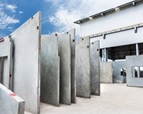You are here: Home » Construction » Concrete Testing » Concrete Failure Analysis
Failure Analysis and Forensic Investigations
Concrete is a widely used precast element and used in-situ in walls, floors, foundations and structural components. There are rules in Eurocode 2 for use of concrete with regards to strength, durability, fire resistance and movement tolerances. When installations fail, a forensic examination is required to understand the failure mechanism in order to: detail methods of repair, understand the consequences of the failure, or ultimately, to be able to define culpability.
Lucideon has a number of techniques available for forensic/failure analysis which can be split into two categories; site investigation followed by laboratory analysis.
Site Investigation
An initial desk study will be followed by a visual site inspection to assess the failure mode. Depending on the apparent failure, a programme of intrusive and non-intrusive sampling can be carried out:
Intrusive coring of samples to establish:
- Depth of cover to rebar
- Construction of slab/column/beam
- Presence of honeycombing
- Moisture content and density
- Depth of foundation.
Non-intrusive investigation:
- Mapping of rebars using Hilti Ferroscan
- Presence of voids using Ground Penetrating Radar (GPR)
- Estimated compressive strength using Schmidt Hammer or Windsor Pin
- Presence of movement joints
- Drop hammer testing of screeds to establish strength
- Slip/skid testing of surface
- Half cell potential.
Laboratory Analysis
- Compressive strength*
- Mix proportions including identification of additives*
- Petrographic analysis*
- Sulphate content*
- Chloride content*
- Depth of carbonation
- Alkali silica reaction
- Presence of High Alumina Cement (HAC)*
Lucideon is a UKAS accredited test laboratory for many tests to BS 1881 and BS EN 12390, including the ones marked with an *.
Petrographic Testing
Petrographic analysis is a diagnostic tool for examining failures in concrete.
Once onsite, we can carry out an initial visual examination of the area in order to ascertain possible causes of the problem and to determine the best position for taking samples. Our engineers can take core samples and return them to the laboratory where thin sections will be prepared for examination using Scanning Electron Microscopy (SEM) and Polarized Light Microscopy (PLM).
Petrographic analysis is carried out in accordance with both European and American standards: BS 1881-211:2016, ASTM C295, ASTM C856 and ASTM C457.
Benefits of petrographic examination include:
- Determining the present condition of previously placed concrete so that the decision to re-use or replace can be decided
- Establishing the root cause of surface scaling, spalling, aggregate pop-outs and abrasion
- Defining cracks by type and uncovering crack mechanisms
- Explaining causes of concrete degradation; primary mechanisms are:
- Alkali-Silica Reaction (ASR)
- Alkali-Carbonate Reaction (ACR)
- Sulfate attack
- Effects of chemical attack (including chlorides)
- Assessing the entrained air content
- Establishing the water/cement ratio
- Determining the density, absorption and volume of permeable voids (as defined in ASTM C642)
- Revealing the root cause(s) of low compressive strength with key milestones at 7, 28 and 56 days
- Comparing hardened concrete to known mix designs
- Assessing fire damage.
Forensic analysis can be supplemented by additional techniques which also include, but are not limited to chemical analysis, SEM and X-Ray Diffraction (XRD).


